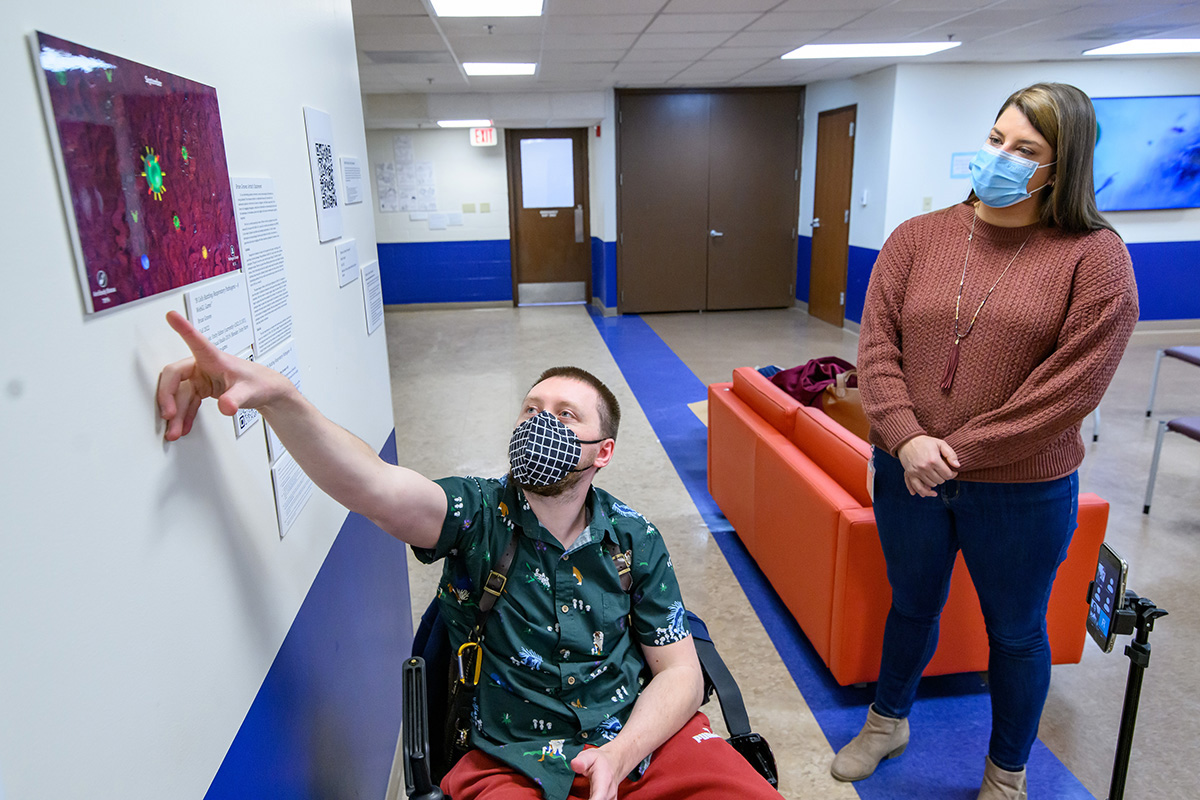Teaching generations of students about outbreaks – with art
by Jessica Brinkworth (GNDP/IGOH), Anthropology Professor
Most people don’t visit the health department to view student art, but here we are, in the busy main hall of the Champaign-Urbana Public Health District. We are wearing face masks, reading artist statements and reviewing more than a dozen visual and digital explorations of influenza, respiratory syncytial virus, COVID-19 and – the trickiest of all health topics – human behavior. Nurses and dental assistants whiz by with young patients. People walk by to pick up birth certificates. Two kids sit in a corner and play with one of the art pieces.

It’s obvious this isn’t just an art show. It’s an end-of-term presentation designed by students in my evolutionary immunology class for students in kindergarten through the eighth grade. These creative works are meant to show the youngsters how to prevent the spread of respiratory infections in the community. These kids are using the art exactly the way it was intended.
The art show is a midpoint in a journey to revamp the health district’s Germ Busters program, which conducts outreach to K-8 students on a variety of infectious diseases. Originally launched in 2009, the program first focused on the H1N1 influenza virus. A lot has changed since then, including the emergence of new diseases, shifts in the seasonal peaks of common respiratory infections and our scientific understanding of multiple respiratory pathogens.
The Germ Busters reboot emphasizes the biology behind major respiratory infection outbreaks, the defenses humans have to suppress their spread and the consequences to the community when we fail to mitigate these infections.
My students are leveraging what they learned in class to produce learning packets for the younger students. These lessons teach infection biology and prevention, and they meet the Illinois Learning Standards for each grade. Students are also learning about the Champaign County community and the challenges it faces when outbreaks swell.
As I look around at the artwork and watch my students interacting with people in the health district, I think about all the weeks of classwork that led up to this event. Along with lessons on the biology of specific pathogens, my students learned how to assess community demographics and how to design and conduct outreach using effective science communication. They delved into the evolution of adaptive immunity, learned how the environment affects immune function and pondered the factors that cause hosts and pathogens to coevolve.
Each week of the class, my students applied these and other concepts in class assignments that involved producing outreach materials. They also heard from experts like Whitney Greger, the health district’s director of wellness and health promotion; and Dan Cermack, a gaming expert and informatician at the University of Illinois Urbana-Champaign.
The final product is this art show of coloring sheets, board games, online quizzes, video games, science experiments, songs, sculpture and children’s books based on an understanding not just of immunology and pathogens, but the needs of our state and county. All this material will soon be organized into five-day curricular packages to beta-test with local students.
Some grades will need even more activities, so another of my classes, Human Health and Disease, will pick up the baton and create the next set of activities to complete those packages.
Standing in the health district halls, I think about how these college students will influence effective health communication and how some of the K-8 students who benefit from their work will carry their new knowledge forward, perhaps also becoming ambassadors for effective public health policy and education into the future. And that’s the big win.
